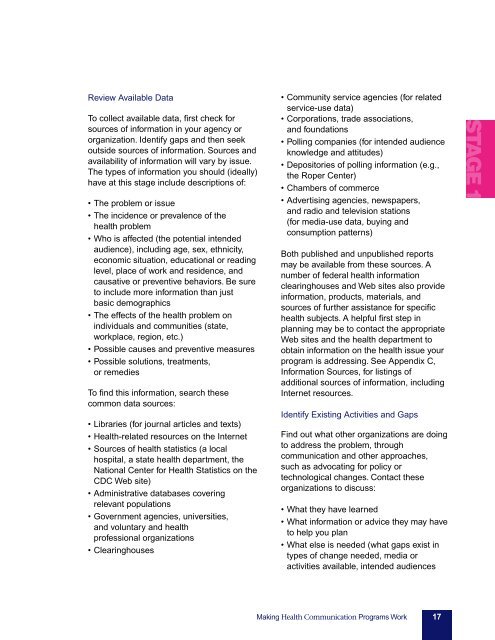pink-book
pink-book
pink-book
Create successful ePaper yourself
Turn your PDF publications into a flip-book with our unique Google optimized e-Paper software.
Review Available Data<br />
To collect available data, first check for<br />
sources of information in your agency or<br />
organization. Identify gaps and then seek<br />
outside sources of information. Sources and<br />
availability of information will vary by issue.<br />
The types of information you should (ideally)<br />
have at this stage include descriptions of:<br />
• The problem or issue<br />
• The incidence or prevalence of the<br />
health problem<br />
• Who is affected (the potential intended<br />
audience), including age, sex, ethnicity,<br />
economic situation, educational or reading<br />
level, place of work and residence, and<br />
causative or preventive behaviors. Be sure<br />
to include more information than just<br />
basic demographics<br />
• The effects of the health problem on<br />
individuals and communities (state,<br />
workplace, region, etc.)<br />
• Possible causes and preventive measures<br />
• Possible solutions, treatments,<br />
or remedies<br />
To find this information, search these<br />
common data sources:<br />
• Libraries (for journal articles and texts)<br />
• Health-related resources on the Internet<br />
• Sources of health statistics (a local<br />
hospital, a state health department, the<br />
National Center for Health Statistics on the<br />
CDC Web site)<br />
• Administrative databases covering<br />
relevant populations<br />
• Government agencies, universities,<br />
and voluntary and health<br />
professional organizations<br />
• Clearinghouses<br />
• Community service agencies (for related<br />
service-use data)<br />
• Corporations, trade associations,<br />
and foundations<br />
• Polling companies (for intended audience<br />
knowledge and attitudes)<br />
• Depositories of polling information (e.g.,<br />
the Roper Center)<br />
• Chambers of commerce<br />
• Advertising agencies, newspapers,<br />
and radio and television stations<br />
(for media-use data, buying and<br />
consumption patterns)<br />
Both published and unpublished reports<br />
may be available from these sources. A<br />
number of federal health information<br />
clearinghouses and Web sites also provide<br />
information, products, materials, and<br />
sources of further assistance for specific<br />
health subjects. A helpful first step in<br />
planning may be to contact the appropriate<br />
Web sites and the health department to<br />
obtain information on the health issue your<br />
program is addressing. See Appendix C,<br />
Information Sources, for listings of<br />
additional sources of information, including<br />
Internet resources.<br />
Identify Existing Activities and Gaps<br />
Find out what other organizations are doing<br />
to address the problem, through<br />
communication and other approaches,<br />
such as advocating for policy or<br />
technological changes. Contact these<br />
organizations to discuss:<br />
• What they have learned<br />
• What information or advice they may have<br />
to help you plan<br />
• What else is needed (what gaps exist in<br />
types of change needed, media or<br />
activities available, intended audiences<br />
STAGE 1<br />
Making Health Communication Programs Work 17


